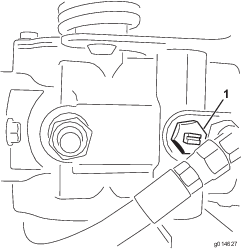| Maintenance Service Interval | Maintenance Procedure |
|---|---|
| Before each use or daily |
|
Introduction
This machine is a ride-on, reel-blade lawn mower intended to be used by professional, hired operators in commercial applications. It is primarily designed for cutting grass on well-maintained lawns in parks, golf courses, sports fields, and on commercial grounds. It is not designed for cutting brush, mowing grass and other growth alongside highways, or for agricultural uses.
Read this information carefully to learn how to operate and maintain your product properly and to avoid injury and product damage. You are responsible for operating the product properly and safely.
You may contact Toro directly at www.Toro.com for product and accessory information, help finding a dealer, or to register your product.
Whenever you need service, genuine Toro parts, or additional information, contact an Authorized Toro Distributor and have the model and serial numbers of your product ready. Figure 1 identifies the location of the model and serial numbers on the product. Write the numbers in the space provided.
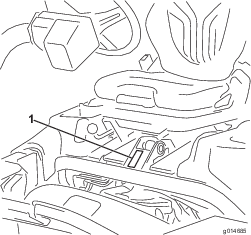
This manual identifies potential hazards and has safety messages identified by the safety-alert symbol (Figure 2), which signals a hazard that may cause serious injury or death if you do not follow the recommended precautions.

This manual uses 2 words to highlight information. Important calls attention to special mechanical information and Note emphasizes general information worthy of special attention.
This product complies with all relevant European directives; for details, please see the separate product specific Declaration of Conformity (DOC) sheet.
Warning
CALIFORNIA
Proposition 65 Warning
The engine exhaust from this product contains chemicals known to the State of California to cause cancer, birth defects, or other reproductive harm.
This spark ignition system complies with Canadian ICES-002
It is a violation of California Public Resource Code Section 4442 or 4443 to use or operate the engine on any forest-covered, brush-covered, or grass-covered land unless the engine is equipped with a spark arrester, as defined in Section 4442, maintained in effective working order or the engine is constructed, equipped, and maintained for the prevention of fire.
Safety
This machine has been designed in accordance with EN ISO 5395:2013 and ANSI B71.4-2012 and meets these standards when you add the appropriate weight kit.
General Safety
This product is capable of amputating hands and feet and of throwing objects. Always follow all safety instructions to avoid serious personal injury.
Using this product for purposes other than its intended use could prove dangerous to you and bystanders.
-
Read and understand the contents of this Operator’s Manual before starting the engine.
-
Do not put your hands or feet near moving components of the machine.
-
Do not operate the machine without all guards and other safety protective devices in place and working on the machine.
-
Keep clear of any discharge opening. Keep bystanders and pets a safe distance away from the machine.
-
Keep children out of the operating area. Never allow children to operate the machine.
-
Stop the machine and shut off the engine before servicing, fueling, or unclogging the machine.
Improperly using or maintaining this machine can result in injury. To reduce the potential for injury, comply with these safety instructions and always pay attention to the safety-alert symbol, which means Caution, Warning, or Danger—personal safety instruction. Failure to comply with these instructions may result in personal injury or death.
You can find additional safety information where needed throughout this Operator’s Manual.
Safety and Instructional Decals
 |
Safety decals and instructions are easily visible to the operator and are located near any area of potential danger. Replace any decal that is damaged or missing. |




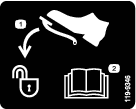
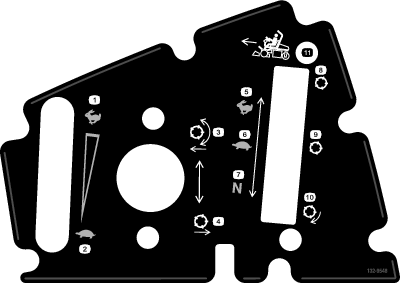
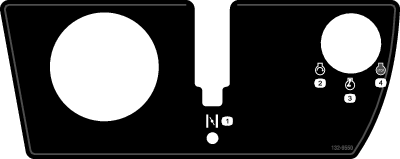

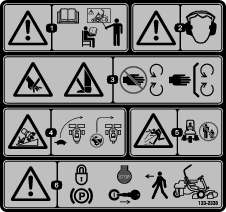
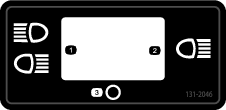
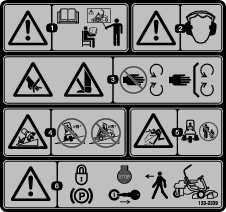
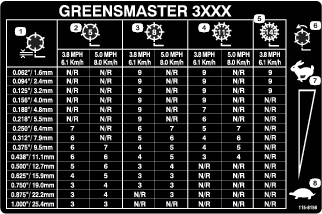
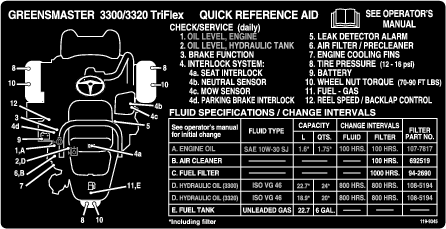
Setup
Installing the Roll Bar
Parts needed for this procedure:
| Roll bar | 1 |
| Bolt (1/2 x 3-3/4 inches) | 4 |
| Flange-nut (1/2 inch) | 4 |
-
Remove the top crate support from the crate.
-
Remove the roll bar from the crate.
-
Install the roll bar into the pockets on each side of the machine, using 4 bolts (1/2 x 3-3/4 inches) and 4 flange-nuts (1/2 inch) as shown in Figure 3.
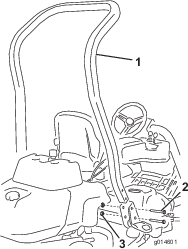
-
Torque the fasteners to 136 to 149 N∙m (100 to 110 ft-lb).
Installing the Seat
Parts needed for this procedure:
| Seat | 1 |
| Seat wiring harness | 1 |
Note: Mount the seat in the front set of mounting holes to gain an additional 7.6 cm (3 inches) in the forward adjustment, or in the rear mounting holes for an additional 7.6 cm (3 inches) in the rearward adjustment.
-
Remove and discard the lag bolts securing the seat slides and cut the shipping straps.
-
Remove the 4 bolts (5/16 x 3/4 inch) and washers from the shipping bracket and discard the bracket.
-
Secure the seat to the seat base with 4 bolts and washers removed previously (Figure 4).
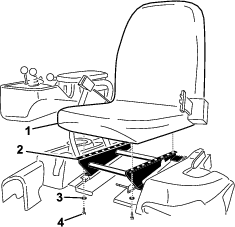
-
Locate the open connector on the main wiring harness to the right of the seat and connect it to the wiring harness that came with the seat.
-
Route the seat wiring harness around the seat slides, ensuring that it will not be pinched when the seat moves, and connect it to the port on the bottom of the seat.
Installing the Steering Wheel
Parts needed for this procedure:
| Steering wheel | 1 |
| Locknut (1-1/2 inches) | 1 |
| Washer | 1 |
| Steering-wheel cap | 1 |
-
Slide the steering wheel onto the steering shaft (Figure 5).
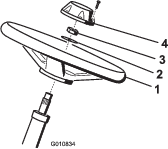
-
Slide the washer onto the steering shaft (Figure 5).
-
Secure the steering wheel to the shaft with a locknut and tighten it to 27 to 35 N∙m (20 to 26 ft-lb) (Figure 5).
-
Install the cap to the steering wheel and secure it with 6 bolts (Figure 5).
Activating and Charging the Battery
Use only electrolyte (1.265 specific gravity) to fill the battery initially.
Warning
CALIFORNIA
Proposition 65 Warning
Use of this product may cause exposure to chemicals known to the State of California to cause cancer, birth defects, or other reproductive harm.
-
Remove the fasteners and battery clamp and lift out the battery.
Important: Do not add electrolyte while the battery is in the machine. You could spill it, causing corrosion.
-
Clean the top of the battery and remove the vent caps (Figure 6).

-
Carefully fill each cell with electrolyte until the plates are covered with about 6 mm (1/4 inch) of fluid (Figure 7).
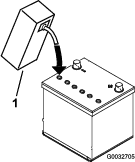
-
Allow approximately 20 to 30 minutes for the electrolyte to soak into the plates. Fill as necessary to bring the electrolyte to within about 6 mm (1/4 inch) of the bottom of the fill well (Figure 7).
-
Connect a 2 to 4 A battery charger to the battery posts. Charge the battery for at least 2 hours at 4 A or for at least 4 hours at 2 A until the specific gravity is 1.250 or higher and the temperature is at least 16°C (60°F) with all cells gassing freely.
Warning
Charging the battery produces gasses that can explode.
Never smoke near the battery and keep sparks and flames away from the battery.
Important: If you do not charge the battery for at least the time specified above, you may reduce the life of the battery.
-
When the battery is charged, disconnect the charger from the electrical outlet and battery posts.
Note: After the battery has been activated, add only distilled water to replace normal loss, although maintenance-free batteries should not require water under normal operating conditions.
Warning
Battery terminals or metal tools could short against metal tractor components causing sparks. Sparks can cause the battery gasses to explode, resulting in personal injury.
-
When removing or installing the battery, do not allow the battery terminals to touch any metal parts of the tractor.
-
Do not allow metal tools to short between the battery terminals and metal parts of the tractor.
Important: Failure to correctly activate the battery may result in battery gassing and/or premature battery failure.
-
-
Install the vent caps.
-
Place the battery on the battery tray and secure it with the battery clamp and fasteners removed previously.
-
Install the positive cable (red) to the positive (+) terminal and then the negative cable (black) to the negative (–) terminal of the battery and secure them with the bolts and nuts (Figure 8). Slide the rubber boot over the positive terminal to prevent a possible short from occurring.
Warning
Incorrect battery cable routing could damage the tractor and cables causing sparks. Sparks can cause the battery gasses to explode, resulting in personal injury.
-
Always disconnect the negative (black) battery cable before disconnecting the positive (red) cable.
-
Always connect the positive (red) battery cable before connecting the negative (black) cable.
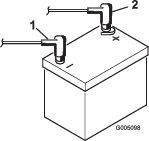
Installing the Oil Cooler (optional)
If you are operating the machine in hot climates, where the ambient temperature is above 29° C (85° F), or using it for heavy-duty use (mowing other than greens, such as fairways or verticutting), install a Hydraulic Oil Cooler Kit, Part No. 119-1691.
Installing the Grass-Basket Hooks
Parts needed for this procedure:
| Grass-basket hook | 6 |
| Flange bolts | 12 |
Install the 6 grass-basket hooks onto the ends of the suspension-arm bars using the 12 flange bolts (Figure 9).
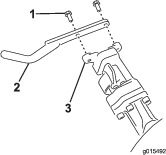
Installing the Cutting Units
Parts needed for this procedure:
| Gauge bar | 1 |
| Cutting unit (obtain from your Toro Distributor) | 3 |
| Grass basket | 3 |
| Electric-reel-motor counterweight | 3 |
| Capscrew | 6 |
-
Setup the cutting units as described in the cutting unit Operator’s Manual.
-
Apply grease to the inside diameter of the drive coupler.
-
Install the electric-reel-motor counterweight as described in Installing the Electrical Counterweights.
-
Install the cutting units as described in Installing the Cutting Units.
Setting the Clip-Control Feature
To achieve a consistent, high quality-of-cut and a uniform after cut appearance, the machine has a clip-control feature that varies the speed of the reels with the speed of the machine, to maintain a constant clip. This feature is OFF by default; to configure it and turn it ON, refer to Setting the Clip-Control Feature
Adding Rear Weight
Parts needed for this procedure:
| Weight kit (Part No. 119-7129)—sold seperately | 1 |
This unit complies with the ANSI B71.4-2012 and EN ISO 5395:2013 Standards when equipped with the Weight Kit, Part No. 119-7129.
Installing EU Decals
Parts needed for this procedure:
| Warning decal (Part No. 133-2339) | 1 |
If this machine will be used in the EU, affix the warning decal 133-2339 over English warning decal 133-2338.
Reducing the Tire Pressure
The tires are over-inflated at the factory for shipping purposes. Reduce the pressure to the proper levels before starting the machine. Refer to Checking the Tire Pressure.
Burnishing the Brakes
Firmly apply the brakes and drive the machine at mowing speed until the brakes are hot, as indicated by their smell. You may need to adjust the brakes after the break-in period; refer to Adjusting the Brakes.
Product Overview
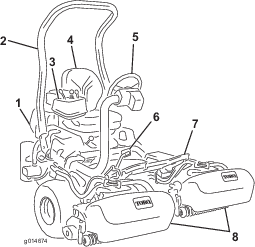
Traction Pedal
The traction pedal (Figure 11) has 3 functions: to make the machine move forward, to move it backward, and to stop the machine. Press the top of the pedal to move forward and the bottom of the pedal to move backward or to assist in stopping when moving forward. Also, allow the pedal to move to the neutral position to stop the machine. For operator comfort, do not rest the heel of your foot on reverse when operating forward (Figure 12).
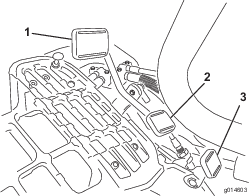

Ground speeds are as follows:
-
3.2 to 8 km/h (2 to 5 mph) forward mowing speed
-
16 km/h (10 mph) maximum transport speed
-
4.0 km/h (2.5 mph) reverse speed
Steering-Arm-Locking Pedal
Press the pedal (Figure 11) and raise or lower the steering arm for operator comfort, then, release the pedal to lock the arm in place.
Throttle Lever
The throttle lever (Figure 13) allows you to control the speed of the engine. Move the throttle lever toward the FAST position to increases the engine speed; move it toward the SLOW position to decrease the engine speed.
Note: You cannot stop the engine using the throttle lever.
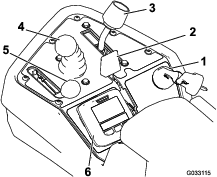
Choke Lever
To start a cold engine, close the carburetor choke by pushing the choke lever forward (Figure 13) to the CLOSED position. After the engine starts, regulate the choke lever to keep the engine running smoothly. As soon as possible, open the choke by pulling the lever rearward to the OPEN position. A warm engine requires little or no choking.
Raise/Lower Mow Control
Moving the control (Figure 13) forward during operation lowers the cutting units and starts the reels. Pull back on the control to stop the reels and raise the cutting units. During operation, you can stop the reels by pulling back on the control momentarily and releasing it. Start the reels by moving the control forward.
Functional-Control Lever
The functional-control lever (Figure 13) provides 2 traction selections plus a NEUTRAL position. You can shift from mow to transport or transport to mow (not to neutral) while the machine is in motion; no damage will result.
-
REAR position—neutral and backlapping
-
MIDDLE position—used for mowing operation
-
FRONT position—used for transport operation
Ignition Switch
Insert the key into the switch (Figure 13) and turn it clockwise as far as possible to the START position to start the engine. Release the key as soon as the engine starts; the key moves to the ON position. Turn the key counterclockwise to the OFF position to shut off the engine.
Parking-Brake Lever
Pull up on the brake lever (Figure 14) to set the parking brake. Disengage it by squeezing the release lever on the underside of the brake lever and lowering it down to the released position. Lock the parking brake any time you leave the machine.
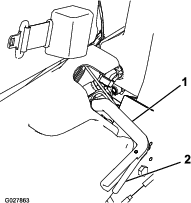
InfoCenter Control
Using the InfoCenter LCD Display
The InfoCenter LCD display shows information about your machine such as the generator status, the speed, and various diagnostics and other information about the machine and the battery pack. Figure 15 and Figure 16 illustrate the splash screen and main information screen of the InfoCenter. You can switch between the splash screen and main information screen at any time by pressing any of the InfoCenter buttons and then selecting the appropriate directional arrow.

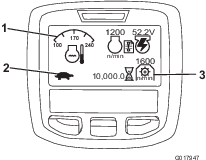
-
ENGINE RPM/STATUS—indicates the engine rpm.
-
FAULT LOG—indicates that there is a current fault log to review.
-
GENERATOR VOLTAGE/STATUS—indicates the generator voltage.
-
HOUR METER—indicates the total hours that the machine has operated. It starts to function whenever the key switch is rotated to On.
-
PTO SPEED—indicates the PTO speed.
-
BATTERY VOLTAGE—indicates the battery potential in Volts.
-
COOLANT TEMPERATURE—indicates the engine coolant temperature in either °C or °F.
-
FUNCTIONAL CONTROL STATUS—transport mode is indicated by a rabbit and mow mode is indicated by a turtle.
-
ENGINE OIL PRESSURE light—this icon appears if the engine oil pressure drops below a safe level.
-
MENU ACCESS/BACK button—press this button to access the InfoCenter menus. You can use it to back out of any menu you are currently using.
-
DOWN button—use this button to scroll down menus.
-
RIGHT button—use this button to open a menu where a right arrow indicates additional content.
Note: The purpose of each button may change depending on what is required at the time. Each button is labeled with an icon displaying its current function.
Using the Menus
To access the InfoCenter-menu system, press the MENU ACCESS button while at the main screen. This brings you to the MAIN MENU. Refer to the following tables for a synopsis of the options available from the menus:
| MAIN MENU | |
| Menu Item | Description |
| FAULTS | The FAULTS menu contains a list of the recent machine faults. Refer to the Service Manual or your Authorized Toro Distributor for more information on the FAULTS menu and the information contained there. |
| SERVICE | The SERVICE menu contains information on the machine such as hours of use and other similar numbers. |
| DIAGNOSTICS | The DIAGNOSTICS menu lists various states that the machine currently has. You can use this to troubleshoot certain issues as it will quickly tell you which machine controls are on and which are off. |
| SETTINGS | The SETTINGS menu allows you to customize and modify configuration variables on the InfoCenter display. |
| ABOUT | The ABOUT menu lists the model number, serial number, and software version of your machine. |
| SERVICE | |
| Menu Item | Description |
| HOURS | Lists the total number of hours that the machine, engine, reels, backlap, and fan have been on, as well as the number of hours the machine has been transported and overheated. |
| COUNTS | Lists the number of preheats and starts the machine has experienced. |
| BACKLAP | Turns backlapping ON/OFF (once ON you can turn backlapping Off with this setting or by turning off the ignition key). |
| DIAGNOSTICS | |
| Menu Item | Description |
| ENGINE RUN | Indicates if the following items are active: Key start, key run, joystick lower, joystick raise, neutral, seat or parking brake, OK run, and RTR or ETR. |
| S1–S4 | Controls the raising and lowering of the solenoids. |
| REELS ENABLE | Indicates if the eReel is enabled. |
| SETTINGS | |
| Menu Item | Description |
| UNITS | Controls the units used on the InfoCenter. The menu choices are English or metric. |
| LANGUAGE | Controls the language used on the InfoCenter. |
| LCD BACKLIGHT | Controls the brightness of the LCD display. |
| LCD CONTRAST | Controls the contrast of the LCD display. |
| PROTECTED MENUS | Allows the distributor/engineer to access protected menus by inputting a passcode. |
| PROTECTION SETTINGS | Controls the protected menus. |
| RESET DEFAULTS | Resets the InfoCenter to default settings. |
| RAISE DELAY | Controls the raise delay time for the center cutting unit. |
| LOWER DELAY | Controls the lower delay for the center cutting unit. |
| TAPOFF DELAY | Controls the tap-off delay. |
| REEL SPEED | Controls the reel speed. |
| BACKLAP RPM | Controls the backlap rpm speed. |
| CLIP CONTROL | Turns the automatic clip-control feature ON/OFF. |
| BLADE COUNT | Set the number of blades in each reel. This setting is only necessary if CLIP CONTROL is set to ON. |
| CLIP (FOC) | Sets the desired clip. This setting is only necessary if CLIP CONTROL is set to ON. |
| ABOUT | |
| Menu Item | Description |
| MODEL | Lists the model number of the machine. |
| SN | Lists the serial number of the machine. |
| TEC 5001 | Lists the software revision of the master controller. |
| INFOCENTER | Lists the software revision of the InfoCenter. |
| CU1 | Lists the software revision of the first cutting unit. |
| CU2 | Lists the software revision of the second cutting unit. |
| CU3 | List the software revision of the third cutting unit. |
| GENERATOR | Lists the serial number of the generator. |
| CAN BUS | Lists the machine communication bus status. |
Adjusting the Center Cutting Unit Raise/Lower Delay
Adjust the raise and lower delay time for the center cutting with the InfoCenter, as desired from 1 to 10 according to the table below. The factory default setting is 6 (375 ms) and is optimized for a 3.8 mph mow speed.
| Increment Number | Delay Time (Seconds) |
| 1 | 0.100 |
| 2 | 0.150 |
| 3 | 0.200 |
| 4 | 0.250 |
| 5 | 0.300 |
| 6 | 0.375 |
| 7 | 0.475 |
| 8 | 0.600 |
| 9 | 0.750 |
| 10 | 0.925 |
Adjusting the Tap-off Delay
The tap-off delay feature allows the cutting units to turn off without raising, and you may adjust it with the InfoCenter. The delay setting represents the maximum time for the raise/lower joystick to remain in the raise position to activate this feature. The factory default setting is 1 which disables this feature.
| Increment Number | Delay Time (Seconds) |
| 1 | Off |
| 2 | 0.050 |
| 3 | 0.100 |
| 4 | 0.150 |
| 5 | 0.200 |
| 6 | 0.250 |
| 7 | 0.300 |
| 8 | 0.350 |
| 9 | 0.400 |
| 10 | 0.450 |
Setting the Clip-Control Feature
To achieve a consistent, high quality-of-cut and a uniform after cut appearance, the machine has a clip-control feature that varies the speed of the reels with the speed of the machine, to maintain a constant clip. This feature is OFF by default; configure it and turn it ON as follows:
-
From the SETTINGS menu, select CLIP CONTROL.
-
Set CLIP CONTROL to ON.
-
From the SETTINGS menu, select BLADE COUNT.
-
Set the BLADE COUNT to match the number of blades in each of your reels.
-
From the SETTINGS menu, select CLIP (FOC)
-
Set CLIP (FOC) to the desired clip setting.
Setting the Reel Speed
The clip-control feature automatically sets the reel speed to match the machine speed. If you choose not to use the clip-control feature, set the reel speed manually as follows:
-
Select the height-of-cut at which the cutting units are set.
-
Choose the desired ground speed best suited for conditions.
-
Using the appropriate graph (Figure 16) for 5–, 8–, 11–, or 14–blade cutting units, determine the proper reel speed setting.
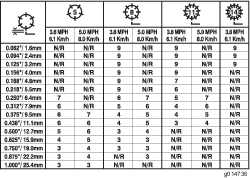
-
To set the reel speed, on the InfoCenter open the Main Menu and scroll down to SETTINGS.
-
In the SETTINGS menu, scroll down to REEL SPEED and use the ± button to set the reel speed to the desired number.
Setting the Machine Configuration Passcode
You can set a passcode on the InfoCenter so that operator’s cannot change the following machine settings without it: RAISE DELAY, LOWER DELAY, TAP-OFF DELAY, REEL SPEED, BACKLAP SPEED, CLIP CONTROL, BLADE COUNT, and CLIP (FOC).
-
From the SETTINGS menu, select PROTECT SETTINGS.
-
Set PROTECT SETTINGS to ON.
-
When prompted, enter a 4-digit passcode.
-
Turn the ignition key to OFF to save the code.
Note: If you forget the user defined passcode, you can obtain a temporary passcode from your authorized Toro distributor.
Diagnosing the Fault-Log Indicator
The fault-log indicator icon appears on the main screen in the event of a fault in the machine. When this icon is present there is a new log entry in the Faults menu that you or your distributor can use to identify the problem.
For a list of faults, refer to your Authorized Toro Distributor or the Service Manual.
Seat-Adjusting Lever
The seat-adjusting lever is located on the front, left corner of the seat (Figure 18), allowing you to adjust the seat forward and rearward.
Note: If you need additional adjustment on the seat, you can remove the 4 nuts securing the seat slide rails to the base and move the seat slide rails to the second set of mounting holes provided.
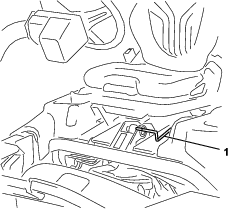
Fuel-Shutoff Valve
Close the fuel-shutoff valve (Figure 19), behind the seat and under the fuel tank, when storing or transporting the machine on a truck or trailer.
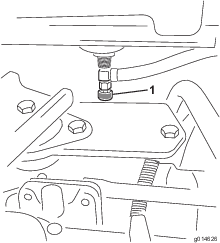
Cutting Unit Power Disconnect Connectors
Before installing, removing, or working on the cutting units, disconnect the cutting units from the power supply by separating the cutting unit power disconnect connectors (Figure 20), located at the base of the rollover bar on the left side of the traction unit. Plug the connectors together before operating the machine.
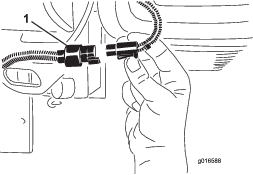
Caution
If you do not disconnect the power to the cutting units, someone could accidentally start the cutting unit, causing serious injury to hands and feet.
Always separate the cutting unit power disconnect connectors before working on the cutting units.
Note: Specifications and design are subject to change without notice.
| Width of cut | 151 cm (59.5 inches) |
| Wheel tread | 128 cm (50.5 inches) |
| Wheel base | 119 cm (46.9 inches) |
| Overall length (w/baskets) | 249 cm (98.0 inches) |
| Overall width | 179 cm (70.6 inches) |
| Overall height | 205 cm (80.8 inches) |
| Weight | Refer to the machine serial tag (Figure 1). |
Attachments/Accessories
A selection of Toro approved attachments and accessories is available for use with the machine to enhance and expand its capabilities. Contact your Authorized Service Dealer or Distributor or go to www.Toro.com for a list of all approved attachments and accessories.
To best protect your investment and maintain optimal performance of your Toro equipment, count on Toro genuine parts. When it comes to reliability, Toro delivers replacement parts designed to the exact engineering specification of our equipment. For peace of mind, insist on Toro genuine parts.
Operation
Note: Determine the left and right sides of the machine from the normal operating position.
Before Operation Safety
General Safety
-
Never allow children or untrained people to operate or service the machine. Local regulations may restrict the age of the operator. The owner is responsible for training all operators and mechanics.
-
Become familiar with the safe operation of the equipment, operator controls, and safety signs.
-
Know how to stop the machine and shut off the engine quickly.
-
Check that operator-presence controls, safety switches, and shields are attached and functioning properly. Do not operate the machine unless they are functioning properly.
-
Before mowing, always inspect the machine to ensure that the blades, blade bolts, and cutting assemblies are in good working condition. Replace worn or damaged blades and bolts in sets to preserve balance.
-
Inspect the area where you will use the machine and remove all objects that the machine could throw.
Fuel Safety
-
Use extreme care in handling fuel. It is flammable and its vapors are explosive.
-
Extinguish all cigarettes, cigars, pipes, and other sources of ignition.
-
Use only an approved fuel container.
-
Never remove the fuel cap or fill the fuel tank while the engine is running or hot.
-
Never refuel the machine in an enclosed space.
-
Never store the machine or fuel container where there is an open flame, spark, or pilot light, such as on a water heater or other appliance.
-
If you spill fuel, do not attempt to start the engine; avoid creating any source of ignition until the fuel vapors have dissipated.
Filling the Fuel Tank
-
Fuel tank capacity: 26.6 L (7 US gallons)
-
Recommended Fuel:
-
For best results, use only clean, fresh (less than 30 days old), unleaded gasoline with an octane rating of 87 or higher ((R+M)/2 rating method).
-
Ethanol: Gasoline with up to 10% ethanol (gasohol) or 15% MTBE (methyl tertiary butyl ether) by volume is acceptable. Ethanol and MTBE are not the same. Gasoline with 15% ethanol (E15) by volume is not approved for use. Never use gasoline that contains more than 10% ethanol by volume, such as E15 (contains 15% ethanol), E20 (contains 20% ethanol), or E85 (contains up to 85% ethanol). Using unapproved gasoline may cause performance problems and/or engine damage, which may not be covered under the warranty.
-
Do not use gasoline containing methanol.
-
Do not store fuel either in the fuel tank or fuel containers over the winter unless you use a fuel stabilizer.
-
Do not add oil to gasoline.
-
Important: Do not use fuel additives other than a fuel stabilizer/conditioner. Do not use fuel stabilizers with an alcohol base such as ethanol, methanol, or isopropanol.
-
Clean around the fuel-tank cap and remove it (Figure 21).

-
Add unleaded regular gasoline to the fuel tank until the level is 25 mm (1 inch) below the bottom of the filler neck.
This space in the tank allows the fuel to expand. Do not fill the fuel tank completely full.
-
Install the cap.
Note: You will hear a click sound when the cap is secure.
-
Wipe up any fuel that may have spilled.
Performing Daily Maintenance
Before starting the machine each day, perform the following procedures:
-
Check the engine-oil level—refer to Checking the Engine Oil.
-
Check the hydraulic-fluid level—refer to Checking the Hydraulic-Fluid Level.
-
Check the reel-to-bedknife contact—refer to Checking the Reel-to-Bedknife Contact.
-
Check the tire pressure—refer to Checking the Tire Pressure.
During Operation Safety
General Safety
-
The owner/operator can prevent and is responsible for accidents that may cause personal injury or property damage.
-
Wear appropriate clothing, including eye protection; slip-resistant, substantial foot protection; and hearing protection. Tie back long hair and do not wear jewelry.
-
Do not operate the machine while ill, tired, or under the influence of alcohol or drugs.
-
Never carry passengers on the machine and keep bystanders and pets away from the machine during operation.
-
Operate the machine only in good visibility to avoid holes or hidden hazards.
-
Avoid mowing on wet grass. Reduced traction could cause the machine to slide.
-
Before you start the engine, ensure that all drives are in neutral, the parking brake is engaged, and you are in the operating position.
-
Keep your hands and feet away from the cutting units. Keep clear of the discharge opening at all times.
-
Look behind and down before backing up to be sure of a clear path.
-
Use care when approaching blind corners, shrubs, trees, or other objects that may obscure your vision.
-
Do not mow near drop-offs, ditches, or embankments. The machine could suddenly roll over if a wheel goes over the edge or if the edge gives way.
-
Stop the cutting units whenever you are not mowing.
-
Stop the machine and inspect the cutting units after striking an object or if there is an abnormal vibration in the machine. Make all necessary repairs before resuming operation.
-
Slow down and use caution when making turns and crossing roads and sidewalks with the machine. Always yield the right-of-way.
-
Disengage the drive to the cutting unit and shut off the engine before adjusting the height of cut (unless you can adjust it from the operating position).
-
Never run an engine in an area where exhaust gasses are enclosed.
-
Never leave a running machine unattended.
-
Before leaving the operating position (including to empty the catchers or to unclog the chute), do the following:
-
Park the machine on level ground.
-
Disengage the power take-off and lower the attachments.
-
Engage the parking brake.
-
Shut off the engine and remove the key.
-
Wait for all moving parts to stop.
-
-
Do not operate the machine when there is the risk of lightning.
-
Do not use the machine as a towing vehicle.
-
Use accessories, attachments, and replacement parts approved by The Toro® Company only.
Rollover Protection System (ROPS) Safety
-
Do not remove the ROPS from the machine.
-
Ensure that the seat belt is attached and that you can release it quickly in an emergency.
-
Always wear your seat belt if your machine has a fixed roll bar.
-
Check carefully for overhead obstructions and do not contact them.
-
Keep the ROPS in safe operating condition by thoroughly inspecting it periodically for damage and keeping all the mounting fasteners tight.
-
Replace a damaged ROPS. Do not repair or alter it.
Slope Safety
-
Establish your own procedures and rules for operating on slopes. These procedures must include surveying the site to determine which slopes are safe for machine operation. Always use common sense and good judgement when performing this survey.
-
Slopes are a major factor related to loss-of-control and tip-over accidents, which can result in severe injury or death. Operating the machine on any slope requires extra caution.
-
Operate the machine at a lower speed when you are on a slope.
-
If you feel uneasy operating the machine on a slope, do not do it.
-
Watch for holes, ruts, bumps, rocks, or other hidden objects. Uneven terrain could overturn the machine. Tall grass can hide obstacles.
-
Choose a low ground speed so you will not have to stop or shift while on a slope.
-
A rollover can occur before the tires lose traction.
-
Avoid operating the machine on wet grass. Tires may lose traction; regardless if the brakes are available and functioning.
-
Avoid starting, stopping, or turning the machine on a slope.
-
Keep all movement on slopes slow and gradual. Do not suddenly change the speed or direction of the machine.
-
Do not operate the machine near dropoffs, ditches, embankments, or bodies of water. The machine could suddenly roll over if a wheel goes over the edge or the edge caves in. Establish a safety area between the machine and any hazard (2 machine widths).
Breaking in the Machine
Refer to the engine manual supplied with the machine for oil change and maintenance procedures recommended during the break-in period.
Only 8 hours of mowing operation is required for the break-in period.
Since the first hours of operation are critical to future dependability of the machine, monitor its functions and performance closely so that minor difficulties, which could lead to major problems, are noted and can be corrected. Inspect the machine frequently during break-in for signs of oil leakage, loose fasteners, or any other malfunction.
Starting and Shutting Off the Engine
Note: Inspect the areas beneath the mowers to be certain they are clear of debris.
Starting the Engine
Note: Inspect the area beneath the mowers to be certain they are clear of debris.
-
Sit on the seat, lock the parking brake, disengage the raise/lower mow control and move the functional-control lever to the NEUTRAL position.
-
Remove your foot from the traction pedal and make sure the pedal is in the NEUTRAL position.
-
Move the choke lever to the CLOSED position (only when starting a cold engine) and the throttle lever to the HALF THROTTLE position.
-
Insert and rotate the ignition key clockwise until the engine starts.
-
After the engine starts, regulate the choke to keep the engine running smoothly. As soon as possible, open the choke by pulling it rearward to the OFF position. A warm engine requires little or no choking.
-
Check the machine out with the following procedures after the engine has started:
-
Move the throttle lever to the FAST position and momentarily engage the reels by moving the raise/lower mow control lever forward. The cutting units should drop and all the reels should turn.
-
Move the raise/lower mow control lever rearward. The cutting reels should stop and the cutting units should raise to the full transport position.
-
Set the brake to keep the machine from moving, and operate the traction pedal through the forward and reverse positions.
-
Continue the above procedure for 1-2 minutes. Move the functional-control lever to the NEUTRAL position, lock the parking brake, and shut off the engine.
-
Check for fluid leaks and tighten the hydraulic fittings if any are found.
Note: When the machine is new and the bearings and reels are tight, it is necessary to use the FAST throttle lever position for this check. A fast throttle setting may not be required after the break-in period.
Note: If fluid leaks continue to appear, contact your Authorized Toro Distributor for assistance and, if necessary, replacement parts.
Important: A trace of fluid on the motor or wheel seals is normal. Seals require a small amount of lubrication to perform properly.
-
Shutting Off the Engine
-
Move the throttle lever to the SLOW position, disengage the raise/lower mow control, and move the functional-control lever to the NEUTRAL position.
-
Rotate the ignition key to the OFF position to shut off the engine. Remove the key from the switch to prevent accidental starting.
-
Close the fuel shut-off valve before storing the machine.
Checking the Safety-Interlock System
Caution
If the safety interlock switches are disconnected or damaged the machine could operate unexpectedly causing personal injury.
-
Do not tamper with the interlock switches.
-
Check the operation of the interlock switches daily and replace any damaged switches before operating the machine.
The purpose of the safety-interlock system is to prevent operation of the machine where there is possible injury to the operator or damage to the machine.
The safety-interlock system prevents the engine from starting unless:
-
The traction pedal is in the NEUTRAL position.
-
The functional-control lever is in the NEUTRAL position.
The safety-interlock system prevents the machine from moving unless:
-
The parking brake is disengaged.
-
The operator is seated.
-
The functional-control lever is in the MOW position or the TRANSPORT position.
The safety-interlock system prevents the reels from operating unless the functional-control lever is in the MOW position.
Perform the following system checks daily to ensure that the interlock system is operating correctly:
-
Sit on the seat, move the traction pedal to the NEUTRAL position, move the functional-control lever to the NEUTRAL position, and engage the parking brake.
-
Try to press the traction pedal.
The pedal should not press, which means that the interlock system is operating correctly. Correct the problem if it is not operating properly.
-
Sit on the seat, move the traction pedal to the NEUTRAL position, move the functional-control lever to the NEUTRAL position, and engage the parking brake.
-
Move the functional-control lever to the MOW position or the TRANSPORT position and try to start the engine.
The engine should not turnover or start, which means that the interlock system is operating correctly. Correct the problem if it is not operating properly.
-
Sit on the seat, move the traction pedal to the NEUTRAL position, move the functional-control lever to the NEUTRAL position, and engage the parking brake.
-
Start the engine and move the functional-control lever to the MOW position or the TRANSPORT position.
The engine should shut off, which means that the interlock system is operating correctly.
Correct the problem if it is not operating properly.
-
Sit on the seat, move the traction pedal to the NEUTRAL position, move the functional control lever to the NEUTRAL position, and engage the parking brake.
-
Start the engine.
-
Release the parking brake, move the functional control lever to the MOW position, and rise from the seat.
The engine should shut off, which means that the interlock system is operating correctly. Correct the problem if it is not operating properly.
-
Sit on the seat, move the traction pedal to the NEUTRAL position, move the functional control lever to the NEUTRAL position, and engage the parking brake.
-
Start the engine.
-
Move the raise/lower mow control forward to lower the cutting units. The cutting units should lower but not start rotating.
If they start rotating, the interlock system is not operating correctly; correct the problem before operating the machine.
Driving the Machine without Mowing
Ensure that the cutting units are fully raised. Move the functional-control lever to the TRANSPORT position. Use the brakes to slow the machine while going down steep hills to avoid loss of control. Always approach rough areas at a reduced speed and cross severe undulations carefully. Familiarize yourself with the width of the machine. Do not attempt to pass between objects that are close together so that costly damage and down time can be prevented.
Mowing
Before mowing greens, find a clear area and practice starting and stopping the machine, raising and lowering the cutting units, turning, etc.
Inspect the green for debris, remove the flag from the cup, and determine the best direction to mow. Base the direction to mow on the previous mowing direction. Always mow in an alternate pattern from the previous mowing so that the grass blades are less apt to lay down and therefore be difficult to trap between the reel blades and the bedknife.
-
Approach the green with the functional-control lever in the MOW position and the throttle at full speed.
-
Start on 1 edge of the green so that you can use the ribbon procedure of cutting.
Note: This holds compaction to a minimum and leaves a neat, attractive pattern on the greens.
-
Actuate the raise/lower mow lever as the front edges of the grass baskets cross the outer edge of the green.
Note: This procedure drops the cutting units to the turf and starts the reels.
Important: The No. 1 cutting unit reel is delayed; therefore, you should practice to gain the required timing necessary to minimize the cleanup mowing operation.
-
Overlap a minimal amount with the previous cut on return passes.
Note: To assist in maintaining a straight line across the green and keep the machine an equal distance from the edge of the previous cut, establish an imaginary sight line approximately 1.8 to 3 m (6 to 10 ft) ahead of the machine to the edge of the uncut portion of the green (Figure 22). Some find it useful to include the outer edge of the steering wheel as part of the sight line; i.e., keep the steering wheel edge aligned with a point that is always kept the same distance away from the front of the machine.
-
As the front edges of the baskets cross the edge of the green, move the raise/lower mow lever rearward and hold it until all the cutting units have risen. This stops the reels and lifts the cutting units.
Note: It is important to time this step correctly so that you do not cut into the fringe area yet cut as much of the green as possible to minimize the amount of grass left to mow around the outer periphery.
-
To cut down on operating time and ease lineup for the next pass, momentarily turn the machine in the opposite direction, then turn it in the direction of the uncut portion; i.e., if intending to turn right, first swing slightly left, then right.
Note: This helps to get the machine more quickly aligned for the next pass. Try to make as short of a turn as possible except during warmer weather when a wider arc minimizes the turf bruising.
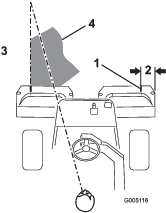
Note: The steering wheel does not return to its original position after you complete a turn.
Important: Never stop the machine on a green with the cutting unit reels operating as damage to the turf may result. Stopping the machine on a wet green may leave marks or indentations from the wheels.
-
If the leak detector alarm (if equipped on your model) sounds or you notice an oil leak while cutting on a green, immediately raise the cutting units, drive directly off the green, and stop the machine in an area away from the green. Determine the cause of the leak and correct the problem.
-
Finish cutting the green by mowing the outer periphery. Be sure to change the direction of cutting from the previous mowing.
Note: Always keep weather and turf conditions in mind and be sure to change the direction of mowing from the previous cutting.
-
When finished mowing the outer periphery, tap the raise/lower mow lever rearward to stop the reels, then drive off the green. When all the cutting units are off of the green, raise them.
Note: This minimizes grass clumps left on the green.
-
Replace the flag.
-
Empty the grass baskets of all clippings before transporting to the next green.
Note: Heavy wet clippings place an undue strain on the baskets and add unnecessary weight to the machine, thereby increasing the load on the engine, hydraulic system, brakes, etc.
After Operation Safety
General Safety
-
Clean grass and debris from the cutting units, drives, mufflers, cooling screens, and engine to help prevent fires. Clean up oil or fuel spills.
-
Shut off the fuel while storing or transporting the machine.
-
Disengage the drive to the attachment whenever you are transporting or not using the machine.
-
Use full-width ramps for loading the machine into a trailer or truck. Do not exceed a 15° angle between the ramp and the trailer or truck.
-
Tie the machine down securely using straps, chains, cable, or ropes. Both front and rear straps should be directed down and outward from the machine.
-
Allow the engine to cool before storing the machine in any enclosure.
-
Never store the machine or fuel container where there is an open flame, spark, or pilot light, such as on a water heater or on other appliances.
Towing Safety
-
Tow only with a machine that has a hitch designed for towing. Do not attach towed equipment except at the hitch point.
-
Follow the manufacturer’s recommendation for weight limits for towed equipment and towing on slopes. On slopes, the weight of the towed equipment may cause loss of traction and loss of control.
-
Never allow children or others in or on towed equipment.
-
Travel slowly and allow extra distance to stop when towing.
Inspecting and Cleaning after Mowing
| Maintenance Service Interval | Maintenance Procedure |
|---|---|
| Before each use or daily |
|
After mowing, thoroughly wash the machine with a garden hose without a nozzle so that excessive water pressure does not contaminate and damage the seals and bearings. Do not wash a warm engine or electrical connections with water.
After cleaning, inspect the machine for possible hydraulic fluid leaks, damage or wear to hydraulic and mechanical components, and the cutting units for sharpness. Also, lubricate the brake-shaft assembly with SAE 30 oil or spray lubricant to deter corrosion and help keep the machine performing satisfactorily during the next mowing operation.
Hauling the Machine
-
Use care when loading or unloading the machine into a trailer or a truck.
-
Use full-width ramps for loading the machine into a trailer or a truck.
-
Tie the machine down securely using straps, chains, cable, or ropes. Both front and rear straps should be directed down and outward from the machine.
Towing the Machine
In case of an emergency, you can tow the machine for up to 0.4 km (1/4 mile).
Important: Do not tow the machine faster than 3 to 5 km/h (2 to 3 mph) to avoid damaging the drive system. If you must move the machine more than 0.4 km (1/4 mile), transport it on a truck or trailer.
Maintenance
Warning
Failure to properly maintain the machine could result in premature failure of machine systems causing possible harm to you or bystanders.
Keep the machine well maintained and in good working order as indicated in these instructions.
Note: Determine the left and right sides of the machine from the normal operating position.
Note: Download a free copy of the electrical or hydraulic schematic by visiting www.Toro.com and searching for your machine from the Manuals link on the home page.
Important: Refer to your engine owner’s manual for additional maintenance procedures.
Caution
If you leave the key in the ignition switch, someone could accidently start the engine and seriously injure you or other bystanders.
Remove the key from the ignition and disconnect the wires from the spark plugs before you do any maintenance. Set the wires aside so that they do not accidentally contact the spark plugs.
Recommended Maintenance Schedule(s)
| Maintenance Service Interval | Maintenance Procedure |
|---|---|
| After the first hour |
|
| After the first 10 hours |
|
| After the first 25 hours |
|
| After the first 50 hours |
|
| Before each use or daily |
|
| Every 50 hours |
|
| Every 100 hours |
|
| Every 200 hours |
|
| Every 400 hours |
|
| Every 800 hours |
|
| Every 2 years |
|
Pre-Maintenance Procedures
Pre-Maintenance Safety
-
Before adjusting, cleaning, repairing, or leaving the machine, do the following:
-
Park the machine on a level surface.
-
Move the throttle switch to the low-idle position.
-
Disengage the cutting units.
-
Lower the cutting units.
-
Ensure that the traction is in neutral.
-
Engage the parking brake.
-
Shut off the engine and remove the key.
-
Wait for all moving parts to stop.
-
Allow machine components to cool before performing maintenance.
-
-
If the cutting units are in the transport position, use the positive mechanical lock (if available) before you leave the machine unattended.
-
If possible, do not perform maintenance while the engine is running. Keep away from moving parts.
-
Use jack stands to support the machine or components when required.
-
Carefully release pressure from components with stored energy.
Lubrication
Greasing the Machine
| Maintenance Service Interval | Maintenance Procedure |
|---|---|
| Every 400 hours |
|
Lubricate the grease fitting with No. 2 lithium grease.
-
Wipe the grease fitting clean so foreign matter cannot be forced into the bearing or bushing (Figure 24).
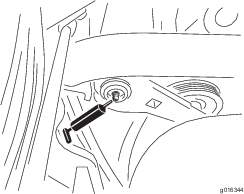
-
Pump grease into the bearing or bushing until the grease is visible. Wipe up excess grease.
Engine Maintenance
Engine Safety
-
Shut off the engine before checking the oil or adding oil to the crankcase.
-
Do not change the governor speed or overspeed the engine.
Servicing the Air Cleaner
| Maintenance Service Interval | Maintenance Procedure |
|---|---|
| Every 50 hours |
|
| Every 100 hours |
|
-
Clean the cover thoroughly (Figure 25).
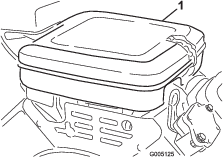
-
Release the locking clips and remove the air-cleaner cover.
-
Remove the wing nut securing the elements to the air-cleaner body (Figure 26).
-
If the foam element is dirty, remove it from the paper element (Figure 26). Clean it thoroughly, as follows:
-
Wash the foam element in a solution of liquid soap and warm water. Squeeze it to remove dirt.
Important: When drying the foam element, do not twist it; the foam may tear.
-
Dry it by wrapping it in a clean rag. Squeeze the rag and foam element dry.
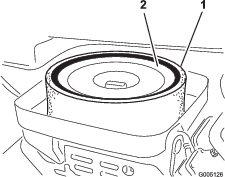
-
-
When servicing the foam element, check the condition of the paper element. Clean it by gently tapping it on a flat surface or replace it if needed.
-
Install the foam element, paper element, wing nut, and air-cleaner cover.
Important: Do not operate the engine without the air-cleaner element because extreme engine wear and damage will likely result.
Servicing the Engine Oil
Checking the Engine Oil
| Maintenance Service Interval | Maintenance Procedure |
|---|---|
| Before each use or daily |
|
The engine is shipped with 1.65 L (1-3/4 US qt) (with filter) of oil in the crankcase; however, you must check the oil level before and after starting the engine the first time.
The engine uses any high-quality detergent oil having the American Petroleum Institute (API) service classification of SG, SH, or SJ or higher. The recommended viscosity (weight) is SAE 30.
-
Position the machine on a level surface.
-
Unscrew the dipstick and wipe it with a clean rag.
-
Screw the dipstick into the tube and ensure that it is seated fully (Figure 27).
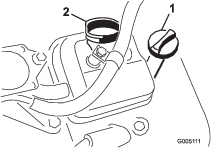
-
Unscrew the dipstick out of the tube and check the oil level.
-
If the oil level is low, remove the filler cap from the valve cover and pour oil into the opening in the valve cover until the oil level is up to the FULL mark on the dipstick. Add the oil slowly and check the level often during this process. Do not overfill.
Important: Check the oil level every 8 operating hours or daily.
-
Install the filler cap and dipstick firmly in place.
Changing the Engine Oil and Filter
| Maintenance Service Interval | Maintenance Procedure |
|---|---|
| After the first 25 hours |
|
| Every 100 hours |
|
-
Remove the drain plug (Figure 28) and let the oil flow into a drain pan. When the oil stops, install the drain plug.
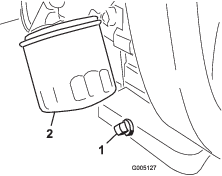
-
Remove the oil filter (Figure 28).
-
Apply a light coat of clean oil to the new filter gasket.
-
Screw the filter on by hand until the gasket contacts the filter adapter, then tighten it 3/4 to 1 turn further. Do not overtighten it.
-
Add oil to the crankcase; refer to Checking the Engine Oil.
-
Dispose of the oil filter and used oil properly.
Replacing the Spark Plugs
| Maintenance Service Interval | Maintenance Procedure |
|---|---|
| Every 800 hours |
|
The recommended air gap is 0.76 mm (0.030 inch)
The correct spark plug to use is a Champion RC 14YC.
Note: The spark plug usually lasts a long time; however, remove and check the plugs whenever the engine malfunctions.
-
Clean the area around the spark plugs so that foreign matter cannot fall into the cylinder.
-
Pull the wires off the spark plugs and remove the plugs.
-
Check the condition of the side electrode, center electrode, and center electrode insulator to ensure that there is no damage.
Important: Replace a cracked, fouled, dirty, or otherwise malfunctioning spark plug. Do not sand blast, scrape, or clean electrodes by using a wire brush because grit may eventually release from the plug, fall into the cylinder, and damage the engine.
-
Set the air gap between the center and side of the electrodes at 0.76 mm (0.030 inch) as shown in Figure 29.
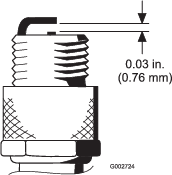
-
Install the correctly-gapped spark plug with a gasket seal, and tighten the plug to 23 N∙m (200 in-lb). If you do not have a torque wrench, tighten the plug firmly.
Fuel System Maintenance
Replacing the Fuel Filter
| Maintenance Service Interval | Maintenance Procedure |
|---|---|
| Every 800 hours |
|
An in-line filter is incorporated into the fuel line between the fuel tank and carburetor (Figure 30).
Danger
In certain conditions, fuel is extremely flammable and highly explosive. A fire or explosion from fuel can burn you and others and can damage property.
-
Drain fuel from the fuel tank when the engine is cold. Do this outdoors in an open area. Wipe up any fuel that spills.
-
Never smoke when draining fuel, and stay away from an open flame or where a spark may ignite the fumes.
-
Close the fuel-shutoff valve, loosen the hose clamp on the carburetor side of filter, and remove the fuel line from the filter (Figure 30).

-
Place a drain pan under the filter, loosen the remaining hose clamp and remove the filter (Figure 30).
-
Install the new filter with the arrow on the filter body pointing away from the fuel tank.
Inspecting the Fuel Lines and Connections
| Maintenance Service Interval | Maintenance Procedure |
|---|---|
| Every 2 years |
|
Inspect the fuel lines for deterioration, damage, or loose connections.
Electrical System Maintenance
Electrical System Safety
-
Disconnect the battery before repairing the machine. Disconnect the negative terminal first and the positive last. Connect the positive terminal first and the negative last.
-
Charge the battery in an open, well-ventilated area, away from sparks and flames. Unplug the charger before connecting or disconnecting the battery. Wear protective clothing and use insulated tools.
Warning
Battery posts, terminals, and related accessories contain lead and lead compounds, chemicals known to the State of California to cause cancer and reproductive harm. Wash hands after handling.
Servicing the Battery
| Maintenance Service Interval | Maintenance Procedure |
|---|---|
| Every 50 hours |
|
Properly maintain the battery electrolyte and keep the top of the battery clean. Store the machine in a cool place to prevent the battery from running down.
Check the electrolyte level every 50 operating hours or, if machine is in storage, every 30 days.
Danger
Battery electrolyte contains sulfuric acid which is a deadly poison and causes severe burns.
-
Do not drink electrolyte and avoid contact with skin, eyes or clothing. Wear safety glasses to shield your eyes and rubber gloves to protect your hands.
-
Fill the battery where clean water is always available for flushing the skin.
Maintain the cell level with distilled or demineralized water. Do not fill the cells above the bottom of the split ring inside each cell.
Keep the top of the battery clean by washing it periodically with a brush dipped in ammonia or bicarbonate of soda solution. Flush the top surface with water after cleaning it. Do not remove the fill caps while cleaning the battery.
The battery cables must be tight on the terminals to provide good electrical contact.
Warning
Incorrect battery cable routing could damage the tractor and cables causing sparks. Sparks can cause the battery gasses to explode, resulting in personal injury.
-
Always disconnect the negative (black) battery cable before disconnecting the positive (red) cable.
-
Always connect the positive (red) battery cable before connecting the negative (black) cable.
If corrosion occurs at the terminals, disconnect the cables, negative (-) cable first, and scrape the clamps and terminals separately. Connect the cables, positive (+) cable first, and coat the terminals with petroleum jelly.
Locating the Fuses
The fuses in the electrical system are located under the seat (Figure 31).

Drive System Maintenance
Checking the Tire Pressure
| Maintenance Service Interval | Maintenance Procedure |
|---|---|
| Before each use or daily |
|
Vary the tire pressure for all 3 wheels, depending upon your turf conditions, from a minimum of 83 to a maximum of 110 kPa (12 psi to 16 psi).
Checking the Torque of the Wheel Nuts
| Maintenance Service Interval | Maintenance Procedure |
|---|---|
| After the first hour |
|
| After the first 10 hours |
|
| Every 200 hours |
|
Warning
Failure to maintain proper torque of the wheel nuts could result in personal injury.
Torque the wheel nuts to 95 to 122 N∙m (70-90 ft-lb) after 1-4 hours of operation and again after 10 hours of operation. Torque every 200 hours thereafter.
To ensure even distribution, torque the wheel nuts in a star pattern.
Adjusting the Transmission for Neutral
If the machine creeps when the traction-control pedal is in the NEUTRAL position, adjust the neutral-return mechanism.
-
Block up under the frame so that one of the front wheels is off of the floor.
Note: If machine is equipped with a 3-Wheel Drive Kit, also raise and block rear wheel.
-
Start the engine, move the throttle to the SLOW position, and ensure that the front wheel that is off of the floor is not rotating.
-
If the wheel is rotating, shut off the engine and proceed as follows:
-
Loosen the nut securing the eccentric to the top of the hydrostat (Figure 32).
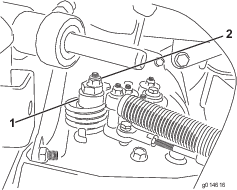
-
Move the functional-control lever to the NEUTRAL position and the throttle to the SLOW position. Start the engine.
-
Rotate the eccentric until creep does not occur in either direction. When the wheel stops rotating, tighten the nut locking the eccentric and the adjustment (Figure 32). Verify the adjustment with the throttle in the SLOW and FAST position.
Note: If the wheel still turns when the eccentric is at the maximum adjustment, contact your Authorized Service Distributor or refer to the Service Manual for further adjustment.
-
Adjusting the Transport Speed
Obtaining the Maximum Transport Speed
The traction pedal is adjusted for maximum-transport speed at the factory, but you may need to adjust it if the pedal reaches full stroke before it contacts the pedal stop, or if you want to a decrease the transport speed.
To obtain the maximum-transport speed, put the functional control lever in the TRANSPORT position and press down on the traction pedal. If the pedal contacts the stop (Figure 33) before you feel tension on the cable, perform the following adjustment procedure:
-
Put the functional-control lever in the TRANSPORT position and loosen the locknut securing the pedal stop to the floor plate (Figure 33).
-
Tighten the pedal stop until it does not contact the traction pedal.
-
Continue applying a light load on the transport pedal and adjust the pedal stop so it contacts the pedal rod and tighten the nuts.
Important: Ensure that the tension on the cable is not excessive or you will reduce the cable life.
Reducing the Transport Speed
-
Press down on the traction pedal and loosen the locknut securing the pedal stop to the floor plate.
-
Loosen the pedal stop until you obtain the desired transport speed.
-
Tighten the locknut securing the pedal stop.
Adjusting the Mowing Speed
The mow speed is set to 3.8 mph at the factory.
The forward moving speed can be adjusted from 0 to 8 km/h (0 to 5 mph).
-
Loosen the jam nut on the trunnion bolt (Figure 34).
-
Loosen the nut securing the lock and mow brackets on the pedal pivot.
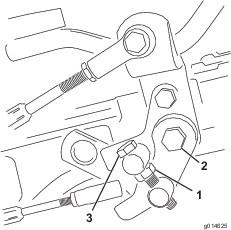
-
Rotate the trunnion bolt clockwise to reduce the mowing speed and counterclockwise to increase the mowing speed.
-
Tighten the jam nut on the trunnion bolt and the nut on the pedal pivot to lock the adjustment (Figure 34). Check the adjustment and adjust as required.
Brake Maintenance
Adjusting the Brakes
If the brake fails to hold the machine while parked, you can adjust the brakes using the bulkhead fitting near the brake drum; contact your Authorized Service Distributor or refer to the Service Manual for more information.
Note: Burnish the brakes annually; refer to Burnishing the Brakes.
Hydraulic System Maintenance
Hydraulic System Safety
-
Ensure that all hydraulic-fluid hoses and lines are in good condition and all hydraulic connections and fittings are tight before applying pressure to the hydraulic system.
-
Keep your body and hands away from pinhole leaks or nozzles that eject high-pressure hydraulic fluid.
-
Use cardboard or paper to find hydraulic leaks.
-
Safely relieve all pressure in the hydraulic system before performing any work on the hydraulic system.
-
Seek immediate medical attention if fluid is injected into skin. Injected fluid must be surgically removed within a few hours by a doctor.
Servicing the Hydraulic Fluid
Checking the Hydraulic-Fluid Level
| Maintenance Service Interval | Maintenance Procedure |
|---|---|
| Before each use or daily |
|
The hydraulic-fluid reservoir is filled at the factory with approximately 25.7 L (6.8 US gallons) of high quality hydraulic fluid. Before operating the machine each day, check the level of the hydraulic fluid. Your machine has or a dipstick or a white plastic window on the front of the hydraulic-fluid reservoir (behind the seat on the left side) that is used to check the hydraulic-fluid level. The fluid should be between the window lines or the dipstick marks; if not, add an appropriate fluid as described in the following sections:
The recommended replacement fluid is as follows:
| Toro Premium All Season Hydraulic Fluid (Available in 5-gallon pails or 55-gallon drums. See parts catalog or Toro distributor for part numbers.) |
Alternate fluids: If the Toro fluid is not available, other fluids may be used provided they meet all the following material properties and industry specifications. We do not recommend the use of synthetic fluid. Consult with your lubricant distributor to identify a satisfactory product
Note: Toro will not assume responsibility for damage caused by improper substitutions, so use only products from reputable manufacturers who will stand behind their recommendation.
| High Viscosity Index/Low Pour Point Anti-wear Hydraulic Fluid, ISO VG 46 | |
| Material Properties: | |
| Viscosity, ASTM D445 | cSt @ 40° C 44 to 48cSt @ 100° C 7.9 to 8.5 |
| Viscosity Index ASTM D2270 | 140 to 160 |
| Pour Point, ASTM D97 | -34° F to -49° F |
| Industry Specifications: | |
| Vickers I-286-S (Quality Level), Vickers M-2950-S (Quality Level), Denison HF-0 | |
Important: The ISO VG 46 Multigrade fluid has been found to offer optimal performance in a wide range of temperature conditions. For operation in consistently high ambient temperatures, 18°C (65°F) to 49°C (120°F), ISO VG 68 hydraulic fluid may offer improved performance.
Premium Biodegradable Hydraulic Fluid-Mobil EAL EnviroSyn 46H
Important: Mobil EAL EnviroSyn 46H is the only synthetic biodegradable fluid approved by Toro. This fluid is compatible with the elastomers used in Toro hydraulic systems and is suitable for a wide-range of temperature conditions. This fluid is compatible with conventional mineral oils, but for maximum biodegradability and performance the hydraulic system should be thoroughly flushed of conventional fluid. The fluid is available in 19 L (5 gallon) containers or 55 gallon drums from your Mobil Distributor.
Important: Many hydraulic fluids are almost colorless, making it difficult to spot leaks. A red dye additive for the hydraulic system fluid is available in 20 ml (2/3 oz) bottles. One bottle is sufficient for 15 to 22 L (4 to 6 gallons) of hydraulic fluid. Order Part No. 44-2500 from your authorized Toro distributor. This red dye is not recommended for use with biodegradable fluids. Use food coloring.
Important: Regardless of the hydraulic fluid type used, any traction unit used for off green applications, verticutting or used during ambient temperatures above 29° C (85°F) should have the Oil Cooler Kit installed; refer to Installing the Oil Cooler (optional).
Filling the Hydraulic Tank
-
Position the machine on a level surface.
Note: Ensure that the machine has cooled down so the oil is cold.
-
Check the fluid level according to the tank on your machine:
-
If your tank has a sight window, check the oil level there (Figure 35) and proceed to step 5.
Note: If the oil level is between the 2 marks on the sight window, the oil level is sufficient.
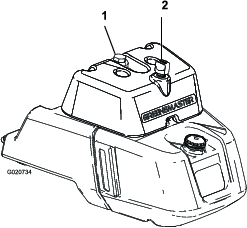
-
If your tank does not have a sight window, locate the dipstick on the top of the main hydraulic tank (Figure 36) and proceed to step 3.
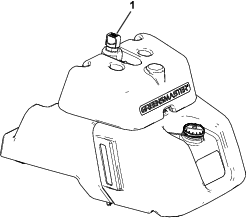
-
-
Remove the dipstick and wipe it with a clean rag, then screw the dipstick back into the tank.
-
Remove the dipstick and check the fluid level. If the fluid is between the marks on the dipstick, the level is sufficient. If the fluid level is not between the marks, more fluid is needed.
-
Remove the cap or dipstick (depending on your machine) from the hydraulic fluid tank and slowly fill the tank with the appropriate high-quality hydraulic fluid until the level is between the 2 marks on the sight window or dipstick.
Important: To prevent system contamination, clean the top of the hydraulic fluid containers before puncturing them. Ensure that the pour spout and funnel are clean.
Note: Do not mix oils.
-
Install the cap.
Note: Perform a close visual inspection of the hydraulic components. Inspect them for issues (e.g., leaks, loose fasteners, missing parts, and improperly routed lines). Make any necessary corrections.
Changing the Hydraulic Fluid and Filter
| Maintenance Service Interval | Maintenance Procedure |
|---|---|
| After the first 50 hours |
|
| Every 800 hours |
|
If the fluid becomes contaminated, have your Toro distributor flush the system. Contaminated fluid looks milky or black when compared to clean fluid.
-
Clean the area around the filter mounting area (Figure 37). Place a drain pan under the filter and remove the filter.
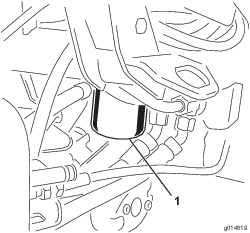
Note: If you will not be draining the fluid, disconnect and plug the hydraulic line going to the filter.
-
Fill the replacement filter with the appropriate hydraulic fluid, lubricate the sealing gasket, and hand turn it until the gasket contacts the filter head. Then tighten it 3/4 turn further.
-
Fill the hydraulic reservoir with hydraulic fluid; refer to Checking the Hydraulic-Fluid Level.
-
Start the machine and run it at idle for 3 to 5 minutes to circulate the fluid and remove any air trapped in the system. Shut off the engine and check the fluid level.
-
Dispose of the fluid and filter properly.
Checking the Hydraulic Lines and Hoses
| Maintenance Service Interval | Maintenance Procedure |
|---|---|
| Before each use or daily |
|
Warning
Hydraulic fluid escaping under pressure can penetrate skin and cause injury.
-
Ensure that all hydraulic fluid hoses and lines are in good condition and all hydraulic connections and fittings are tight before applying pressure to the hydraulic system.
-
Keep your body and hands away from pinhole leaks or nozzles that eject high-pressure hydraulic fluid.
-
Use cardboard or paper to find hydraulic leaks.
-
Safely relieve all pressure in the hydraulic system before performing any work on the hydraulic system.
-
Get immediate medical help if fluid is injected into skin.
Check the hydraulic lines and hoses daily for leaks, kinked lines, loose mounting supports, wear, loose fittings, weather deterioration, and chemical deterioration. Make all necessary repairs before operating.
Checking the Leak Detector
The leak detector system is designed to assist in early detection of hydraulic-fluid-system leaks. If the fluid level in the main hydraulic reservoir is lowered by 118 to 177 ml (4 to 6 oz), the float switch in the tank will close. After a 1 second delay, the alarm sounds, alerting the operator (Figure 40). Expansion of fluid, due to normal heating during machine operation, causes the fluid to transfer into the auxiliary fluid reservoir. The fluid returns to the main tank when you turn off the ignition switch.
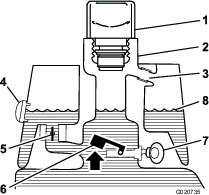
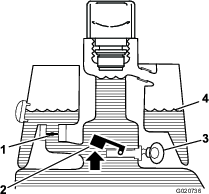
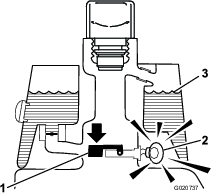
Checking the System Operation
-
With ignition switch in the ON position, move the leak detector switch rearward and hold. After the 1-second delay elapses, the alarm should sound.
-
Release the leak-detector switch.
Checking the Leak-Detector-System Operation
-
Move the ignition switch to the ON position. Do not start the engine.
-
Remove the hydraulic-tank cap from the neck of the tank.
-
Insert a clean rod or screwdriver into the tank neck and gently push down on the switch float (Figure 41); the alarm should sound after the 1-second delay.
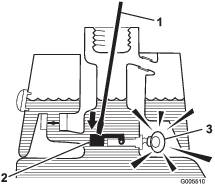
-
Release the float; the alarm should stop sounding.
-
Install the hydraulic-tank cap.
-
Move the ignition switch to the OFF position.
Operating the Leak Detector
The leak detector alarm may sound for 1 of the following reasons:
-
A leak of 118 to 177 ml (4 to 6 oz) has occurred.
-
The fluid level in the main reservoir is reduced by 118 to 177 ml (4 to 6 oz) due to contraction of the fluid by cooling.
If the alarm sounds, turn off the machine as quickly as possible and inspect it for leaks. If the alarm sounds while operating on a green, drive off the green first. Determine the source of the leak and repair it before continuing operation.
If you do not find a leak and suspect a false alarm, move the ignition switch to the OFF position and allow the machine to stand for 1 to 2 minutes to allow the fluid levels to stabilize. Then start the machine and operate it in a non-sensitive area to confirm that no leak exists.
False alarms, due to dluid contraction, may be caused by extended idling of the machine after normal operation. A false alarm may also occur if you work the machine at a reduced workload after an extended period of a heavier workload. To avoid false alarms, turn the machine off rather than idling for extended periods.
Cutting Unit Maintenance
Cutting Unit Safety
A worn or damaged blade or bed-knife can break, and a piece could be thrown at you or bystanders, resulting in serious personal injury or death.
-
Inspect the blades and bed-knives periodically for excessive wear or damage.
-
Use care when checking the blades. Wear gloves and use caution when servicing them. Only replace or backlap the blades and bed-knives; never straighten or weld them.
-
On machines with multiple cutting units, take care when rotating a reel; it can cause the reels in the other cutting units to rotate.
Installing and Removing the Cutting Units
Note: When sharpening, setting the height-of-cut, or performing other maintenance procedures on the cutting units, store the cutting unit reel motors in the storage location on the front of the suspension arms to prevent damage to them.
Important: Do not raise the suspension to the transport position when the reel motors are in the holders in the machine frame. Damage to the motors or hoses could result.
Important: Whenever you need to tip the cutting unit, prop up rear of cutting unit to ensure that the nuts on the bedbar adjusting screws are not resting on work surface (Figure 42).
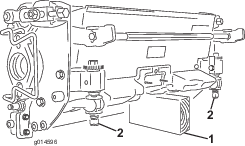
Installing the Electrical Counterweights
Secure the electrical counterweight to the existing counterweight with 2 cap screws as shown in Figure 43.
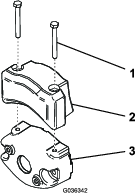
Installing the Cutting Units
-
Disconnect the cutting unit power disconnect couplers; refer to Cutting Unit Power Disconnect Connectors.
Caution
If you do not disconnect the power to the cutting units, someone could accidentally start the cutting unit, causing serious injury to hands and feet.
Always separate the cutting unit power disconnect couplers before working on the cutting units.
-
Lift up on the foot rest and swing it open, allowing access to the center cutting unit position (Figure 44).
Caution
The foot rest can pinch fingers if it falls into the closed position.
Keep your fingers clear of the area where the foot rest seats while it is open.
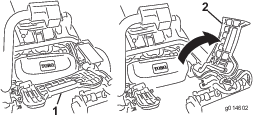
-
Position the cutting unit under the center suspension arm.
-
With the latches on the suspension-arm bar pointing up (i.e., open) (Figure 45), push the suspension arm down so that the bar fits over the bar across the top of the cutting unit (Figure 46).
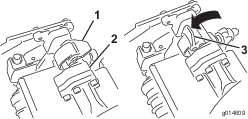
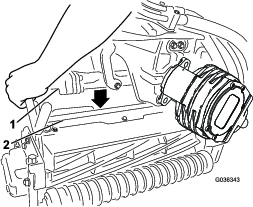
-
Close the latches down and around the cutting-unit bar and lock them in place (Figure 45).
Note: You can hear a click and feel when the latches are properly locked in place.
-
Coat the spline shaft of the cutting unit motor with clean grease (Figure 47).
-
Insert the motor into the left side of the cutting unit (as viewed from the operator's position) and pull the motor retaining bar on the cutting unit toward the motor until you hear a click from both sides of the motor (Figure 47).
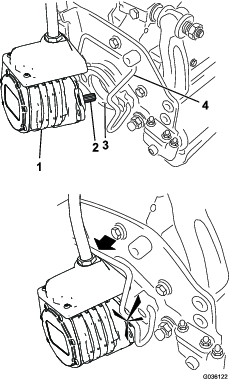
-
Mount a grass basket onto the basket hooks on the suspension arm.
-
Repeat this procedure for the other cutting units.
-
Connect the cutting unit power disconnect couplers; refer to Cutting Unit Power Disconnect Connectors.
Removing the Cutting Units
-
Disconnect the cutting unit power disconnect couplers; refer to Cutting Unit Power Disconnect Connectors.
Caution
If you do not disconnect the power to the cutting units, someone could accidentally start the cutting unit, causing serious injury to hands and feet.
Always separate the cutting unit power disconnect couplers before working on the cutting units.
-
Park the machine on a clean level surface, lower the cutting units to the ground until the suspension hydraulics are fully extended, shut off the engine, and set the parking brake.
-
Push the motor retaining bar out of the slots on the motor toward the cutting unit and remove the motor from the cutting unit.
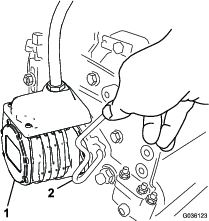
-
Move the motor to the storage location on the front of the suspension arm (Figure 49).
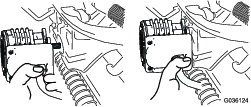
Note: When sharpening, setting the height-of-cut, or performing other maintenance procedures on the cutting units, store the cutting unit reel motors in the storage location on the front of the suspension arms to prevent damage to them.
Important: Do not raise the suspension to the transport position when the reel motors are in the holders in the machine frame. Damage to the motors or hoses could result. If you must move the traction unit without the cutting units installed, secure them to the suspension arms using cable ties.
-
Open the latches on the suspension-arm bar of the cutting unit you are removing (Figure 45).
-
Disconnect the latches from the cutting-unit bar.
-
Roll the cutting unit out from under the suspension arm.
-
Repeat steps 3 through 7 for the other cutting units as required.
-
Connect the cutting unit power disconnect couplers; refer to Cutting Unit Power Disconnect Connectors.
Checking the Reel-to-Bedknife Contact
| Maintenance Service Interval | Maintenance Procedure |
|---|---|
| Before each use or daily |
|
Each day before operating the machine, check the reel-to-bedknife contact, regardless if the quality of cut had previously been acceptable. There must be light contact across the full length of the reel and bedknife; refer to the Cutting Unit Operator’s Manual.
Before checking the reels, disconnect the cutting unit power disconnect couplers; refer to Cutting Unit Power Disconnect Connectors. Connect them when finished.
Backlapping the Reels
Warning
Contact with the reels or other moving parts can result in personal injury.
-
Keep your fingers, hands, and clothing away from the reels or other moving parts.
-
Never attempt to turn the reels by hand or foot while the engine is running.
-
Position the machine on a level surface, lower the cutting units, shut off the engine, and engage the parking brake.
-
Remove the plastic cover to the left side of the seat.
-
Make initial reel to bedknife adjustments appropriate for backlapping on all cutting units which are to be backlapped; refer to the Cutting Unit Operator’s Manual.
-
Start the engine and run at low idle speed. If the engine stalls, increase the engine speed.
-
On the InfoCenter control, from the SERVICE menu, select BACKLAP.
-
Set BACKLAP to ON.
-
Pull up the Main Menu and scroll down to Settings.
-
In the SETTINGS menu scroll down to BACKLAP RPM and use the ± button to select the desired backlap speed.
-
With the functional control lever in the neutral position, move the Raise/Lower Mow control forward to start the backlapping operation on the designated reels.
-
Apply lapping compound with a long handle brush. Never use a short handled brush.
-
If the reels stall or become erratic while backlapping, select a higher reel speed setting until the speed stabilizes.
-
To make an adjustment to the cutting units while backlapping, turn the reels off by moving the Raise/Lower Mow control rearward and shut off the engine. After completing adjustments, repeat steps 4 through 10.
-
Repeat the procedure for all cutting units you want to backlap.
-
When finished, return the InfoCenter BACKLAP setting to OFF or turn the ignition key to the OFF position to return the machine to forward cutting operation.
-
Wash all lapping compound off of the cutting units. Adjust cutting unit reel to bedknife as needed. Move the cutting unit reel speed control to the desired mowing position.
Storage
If you wish to store the machine for a long period of time, the following steps should be performed prior to storage:
-
Remove accumulations of dirt and old grass clippings. Sharpen the reels and bedknives, if necessary; refer to the cutting unit Operator's Manual. Use a rust preventive on bedknives and reel blades. Grease and oil all lubrication points.
-
Block up the wheels to remove any weight on the tires.
-
Drain and replace the hydraulic fluid and filter and inspect the hydraulic lines and fittings. Replace, if necessary; refer to Changing the Hydraulic Fluid and Filter and Checking the Hydraulic Lines and Hoses.
-
All fuel should be removed from the fuel tank. Run the engine until it stops from lack of fuel. Replace the fuel filter; refer to Replacing the Fuel Filter.
-
While the engine is still warm, drain the oil from the crankcase. Refill it with fresh oil; refer to Changing the Engine Oil and Filter.
-
Remove the spark plugs, pour one ounce of SAE 30 oil into the cylinders, and crank slowly to distribute the oil. Replace the spark plugs; refer to Replacing the Spark Plugs.
-
Clean dirt and chaff from the cylinder, cylinder head fins, and blower housing.
-
Remove the battery and charge it fully. Either store it on the shelf or on the machine. Leave the cables disconnected if it is stored on the machine. Store the battery in a cool atmosphere to avoid quick deterioration of the charge in the battery.
-
If possible, store the machine in a warm, dry location.
